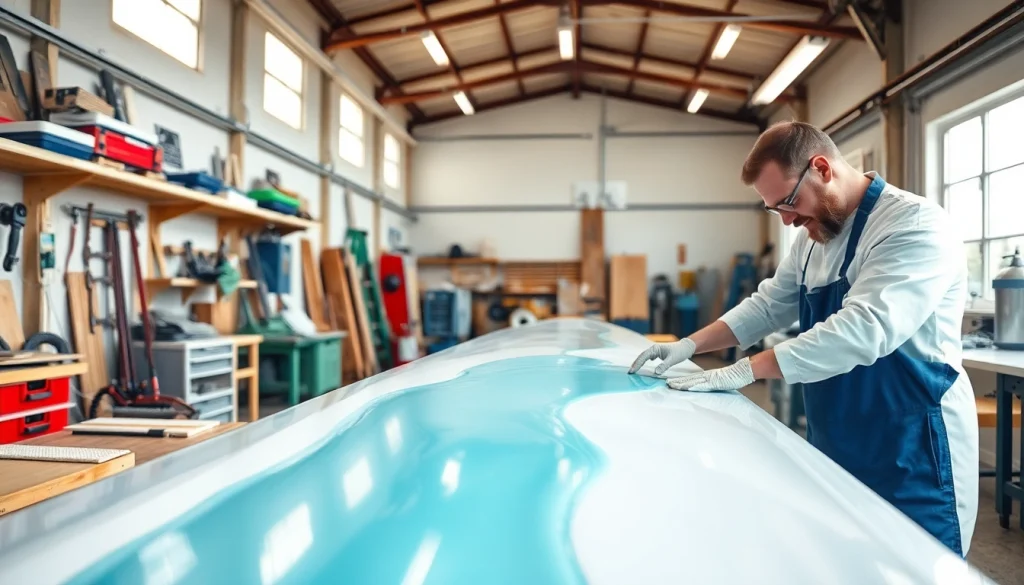Understanding Laminating Resin
What is Laminating Resin?
Laminating resin is a versatile and essential component in numerous construction and crafting applications. Commonly used in the marine, automotive, and general manufacturing industries, laminating resin serves as a binding agent for composites, particularly when working with fiberglass. It provides strength and durability to structures, effectively enhancing their performance and longevity. By using laminating resin, creators can ensure that their projects not only adhere well but also maintain a high-level finish.
Types of Laminating Resin Available
There are several types of laminating resins available on the market, each designed with specific properties to cater to various industrial needs. The two most prominent types are polyester and epoxy laminating resins.
- Polyester Laminating Resin: This type is known for its affordability and ease of use. Polyester laminating resin typically cures faster compared to its epoxy counterpart, making it ideal for larger projects where time efficiency is key. However, it is generally less durable and may not offer the same level of adhesion strength.
- Epoxy Laminating Resin: Epoxy laminating resins are appreciated for their superior bonding capabilities and resistance to chemical exposure. While they may require a longer curing time and are often more costly than polyester options, epoxy resins are preferred for applications where strength and longevity are paramount.
- Vinyl Ester Laminating Resin: Vinyl ester is a hybrid between polyester and epoxy, offering improved chemical resistance and lower shrinkage compared to polyester while generally being less expensive than epoxy. This resin is often used in applications that require high-performance standards but still allow for cost considerations.
Benefits of Using Laminating Resin
Utilizing laminating resin in projects brings numerous advantages. Here are some of the primary benefits:
- Increased Strength: Laminating resin provides enhanced mechanical properties, crucial for load-bearing applications.
- Durability: Both polyester and epoxy resins exhibit high resistance to environmental factors like moisture, UV rays, and chemicals, prolonging the lifespan of your projects.
- Lightweight Composites: Laminating resin works effectively with lightweight materials like fiberglass, resulting in a product that is both strong and light, making it ideal for applications where weight is a concern.
- Flexibility in Application: The different types of laminating resins can be tailored to meet specific requirements, making them suitable for a wide range of applications from boat building to automotive repair.
- Effective Adhesion: Laminating resins create strong bonds between layers of material, ensuring comprehensive integration of composites.
Preparing for Application
Essential Tools and Materials
Before embarking on a project involving laminating resin, it’s crucial to gather all necessary tools and materials. The following list outlines the essentials required for effective application:
- Laminating resin: Choose the appropriate type based on your specific needs—polyester or epoxy.
- Hardener: Particularly for epoxy resins, a compatible hardener is necessary to initiate the curing process.
- Measuring tools: Accurate measurement cups and mixing sticks are vital for achieving the correct resin-to-hardener ratio.
- Application tools: Brushes, rollers, or squeegees can be employed for applying the resin to the fabric or substrate surface.
- Fiberglass mat or cloth: This material will serve as the backbone that the laminating resin adheres to.
- Protective gear: Safety goggles, gloves, and masks are essential to protect against hazardous fumes and resins.
Workspace Setup for Laminating Resin Projects
An organized workspace is key to successful resin application. Here are several considerations when setting up your workspace:
- Ventilation: Ensure your area is well-ventilated to dissipate any fumes emitted by the resin. Working outdoors or in a garage with the doors open is often beneficial.
- Clean Surface: Start with a clean surface to avoid contaminants that could affect adhesion. Making sure the workspace is free of dust and debris is crucial.
- Temperature and Humidity Control: Resins cure best at certain temperatures and humidity levels; typically, they perform optimally in a range of 60°F to 90°F and low humidity.
Safety Considerations
Safety should be a top priority when working with laminating resin. Here are essential safety guidelines:
- Always wear protective gloves, goggles, and appropriate respiratory protection to shield against harmful fumes and skin contact.
- Keep all materials and tools accessible but safely stored when not in use to prevent accidents.
- Read the manufacturer’s safety data sheets (SDS) for specific resins to understand the handling and storage requirements.
Application Techniques
Step-by-Step Guide to Applying Laminating Resin
Applying laminating resin requires attention to detail and a systematic approach. Follow these steps for successful application:
- Preparation: Ensure all tools and materials are ready and your workspace is clean, dry, and well-ventilated.
- Mixing the Resin: Measure the appropriate amounts of laminating resin and hardener according to the product’s specifications. Mix thoroughly in a clean container, ensuring an even consistency.
- Applying the Resin: Using your application tool, apply a generous amount of resin onto the fiberglass mat or cloth. Work in one direction to avoid trapping air bubbles. Saturate the fabric thoroughly for maximum adherence.
- Layering: For multiple layers, ensure the previous one is tacky (but not fully cured) before applying the next. Use the same method for saturation.
- Curing: Allow the application to cure as per the manufacturer’s instructions, ensuring no disturbance during the process.
- Finishing: After curing, inspect your work for any imperfections. Sand or trim as necessary to achieve a smooth finish.
Methods for Achieving Uniform Coats
Achieving an even coat of laminating resin requires practice and skill. Here are some techniques to assist:
- Consistent Pressure: Apply even pressure while using brushes or rollers to ensure uniform thickness across the surface. Avoid over-saturating one area as this can lead to drips.
- Crosshatch Technique: When applying resin with a brush, use a cross-hatch movement to distribute the resin evenly across different directions.
- Inspect Frequently: Regularly check the applied resin for consistency and adjust your technique if you notice areas that are under-saturated.
Common Mistakes to Avoid
Several common pitfalls can lead to poor application results when using laminating resin. Here are some mistakes to avoid:
- Incorrect Mixing Ratios: Always adhere to the recommended mixing ratios provided by the manufacturer. Incorrect ratios can lead to incomplete curing.
- Insufficient Preparation: Failing to prepare your workspace and materials can result in poor adhesion or contamination of the resin.
- Ignoring Cure Time: Patience is critical. Rushing the project by attempting to work before the resin has fully cured can compromise the integrity of the work.
Post-Application Care
Finishing Techniques After Using Laminating Resin
Once you’ve applied the laminating resin, finishing techniques can enhance the aesthetic and functional properties of your project. Here are some steps to consider:
- Sanding: Once cured, sanding can help smooth out imperfections. Use fine-grit sandpaper to avoid deep scratches.
- Painting or Coating: Depending on the intended finish, you may apply paint or a clear coat to enhance appearance and add UV protection.
- Sealing: For added durability, consider applying a sealant over the cured resin, especially for outdoor applications.
How to Store Leftover Laminating Resin
Proper storage of leftover laminating resin can prevent waste and maintain its usability for future projects. Here’s how to store it:
- Seal the resin tightly in its original container or a clean, dry jar to prevent moisture contamination.
- Store in a cool, dark place away from direct sunlight and heat sources to prolong shelf life.
- Label containers with the date of purchase and resin type for easy identification in the future.
Cleaning Up After Use
After completing your laminating project, cleaning up is essential not only for maintaining a tidy workspace but also for safety:
- Wear gloves when handling cured resin to avoid skin irritation.
- Dispose of any empty containers and used materials responsibly, adhering to local disposal regulations.
- Clean tools immediately after use with appropriate solvents before the resin hardens to prevent damage.
Advanced Applications of Laminating Resin
Innovative Uses in Different Industries
Laminating resin finds application in a myriad of industries beyond just construction and crafting. Its innovative uses are continually expanding:
- Aerospace: In aerospace, laminating resin is utilized in the manufacture of lightweight, durable aircraft components, aiding in weight reduction while enhancing structural integrity.
- Automotive: In automotive designs, laminating resin contributes to making car parts lighter and more fuel-efficient while maintaining high strength and durability.
- Wind Energy: Laminating resin plays a critical role in manufacturing wind turbine blades, providing strength to withstand high wind forces.
Combining Laminating Resin with Other Materials
Enhancing the properties of laminating resin through combination with other materials can lead to innovative outcomes. Some synergistic combinations can include:
- Foams: Durability is improved when laminating resin is combined with high-density foams, resulting in lightweight yet strong products.
- Mineral Fillers: Adding mineral fillers can enhance thermal stability and fire resistance in applications requiring additional resilience.
- Composites: Laminating resin works excellently with various composite materials such as aramid fibers or carbon fibers to create lightweight, high-strength products.
Performance Metrics and Testing
To ensure that laminating resin performs effectively, testing and evaluation can take place before and after application. Here are some common performance metrics to consider:
- Tensile Strength: Measuring the tensile strength provides information about the maximum stress the resin can withstand before failure.
- Flexural Strength: This metric indicates the ability of the resin to resist bending forces, which is crucial in applications subjected to load.
- Impact Resistance: Evaluate how well the resin can withstand shock loads without cracking or failing.





